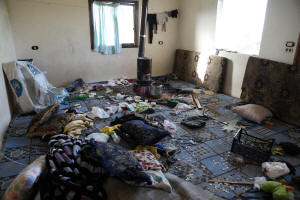Inside U.S. raid on ISIS leader: Months of preparation, then a deadly
blast
 Send a link to a friend
Send a link to a friend
 [February 04, 2022]
By Phil Stewart and Trevor Hunnicutt [February 04, 2022]
By Phil Stewart and Trevor Hunnicutt
WASHINGTON (Reuters) - U.S. forces
rehearsed the helicopter raid over and over, hoping to capture Islamic
State's leader on the third floor of a residential building in a Syrian
town on the Turkish border, where he was holed up with his family.
But before they could reach him, Abu Ibrahim al-Hashemi al-Quraishi
detonated a suicide bomb, triggering a large explosion that blew mangled
bodies -- including his own -- out of the building into the streets
outside.
President Joe Biden, who monitored the raid from the White House's
Situation Room, called Quraishi's suicide a "final act of desperate
cowardice." It echoed of the self-detonation of a bomb by his
predecessor, Islamic State founder Abu Bakr al-Baghdadi, during a U.S.
raid in 2019 in Syria.
For residents in the town of Atmeh, the events were terrifying, as U.S.
forces swept in aboard helicopters before trying to evacuate civilians
from the cinder-block building, using loudspeakers to tell them to
leave.
"Men, women, and children raise your hands. You are in safety of the
American coalition that is surrounding the area. You will die if you
don't get out," said one woman recounting the U.S. warnings.
Marine General Frank McKenzie, who oversees U.S. forces in the region
and was providing updates to Biden, said U.S. troops got six civilians,
including four children, to leave the first floor of the building before
the blast ripped apart the top floor.

"The explosion, which was more massive than would be expected from a
suicide vest, killed everyone on the third floor and in fact ejected
multiple people from the building," McKenzie said, adding that Quraishi,
his wife and two children died.
A second U.S. official later said two of Quraishi's wives and one child
were killed.
As U.S. troops advanced to the second floor, one of Quraishi's
lieutenants and his wife started firing on the Americans and were
killed. One child was found dead there, McKenzie said, and three other
children and an infant were brought to safety from the second floor.
Syrian rescue workers said at least 13 people died, most of them women
and children.
The Pentagon said at least two armed members of a local al Qaeda
affiliate were killed by gunfire from a U.S. helicopter after they
approached the scene of the raid while U.S. troops were still at the
site.
TARGET ON THIRD FLOOR
U.S. officials said Quraishi's death was another setback for a group
that once ruled a self-proclaimed caliphate stretching across territory
in Syria and Iraq. It is now waging insurgent attacks.
Planning for the operation began in early December, when officials
became convinced the Islamic State leader was living in the building,
the officials said. Biden received a detailed briefing on options for
capturing Quraishi alive on Dec. 20, a senior White House official said.
One official said the operation was complicated by the fact Quraishi
rarely left his residence on the building's third floor and relied on
couriers to interact with the outside world.
[to top of second column]
|

Interior of a building destroyed in the aftermath of a
counter-terrorism mission conducted by the U.S. Special Operations
Forces is seen in Atmeh, Syria, February 3, 2022. Mohamed Al-Daher/Handout
via REUTERS

The number of children seen in the area and families believed to be
living on the first floor led U.S. officials to try to craft a mission
aiming to safeguard civilians, they said.
That ultimately required putting U.S. forces at risk in a raid, instead
of launching a remote strike, the officials said.
U.S. military procedures to guard against civilian casualties are under
scrutiny following a high-profile mistaken drone strike in Kabul during
the U.S. evacuation of civilians from Afghanistan that the Pentagon
initially hailed a success.
The Pentagon said it would review all the information from the Atmeh
raid to ensure no civilians were harmed by U.S. forces, but stressed all
indications so far were that civilian deaths were caused by Islamic
State fighters themselves.
Biden gave final approvals for the mission on Tuesday during an Oval
Office meeting with Defense Secretary Lloyd Austin and General Mark
Milley, who as chairman of the Joint Chiefs of Staff is the top American
military officer, U.S. officials said.
Biden, Vice President Kamala Harris and other administration officials
received real-time updates from Austin, Milley and McKenzie as they
watched the operation unfold on several screens from the Situation Room,
the officials said.
Biden joined the group in the Situation Room around 5 p.m. ET on
Wednesday after finishing a call with French President Emmanuel Macron
on an unrelated topic, the White House official said.
At one point, a helicopter involved in the raid suffered a mechanical
failure and had to be destroyed rather than left behind, the Pentagon
said.
Biden said "God bless our troops" once U.S. forces were wheels up after
the operation, and kept tabs on them during the night as they flew to
safety, officials said.
Once U.S. forces were in safety, Biden reflected on an airstrike carried
out in 2015 - when he was serving as vice president - that killed
another ISIS leader and injured Quraishi, costing him a leg, the White
House official said.
Milley told Biden that U.S. forces hit "a visual ID jackpot" when they
viewed Quraishi's body and confirmed his identity using biometric data
taken from a fingerprint during the flight back, the official said. They
waited to announce his death until after a DNA test was completed, the
official added.

"He was on our target list from the earliest days of the campaign. He
was Baghdadi's right-hand man, and ... was personally responsible for
some of the most vicious ISIS atrocities," the official.
(Reporting by Phil Stewart and Trevor Hunnicutt; Additional reporting by
John Davidson, Suleiman Al-Khalidi and Andrea Shalal; Editing by Mary
Milliken, Will Dunham, Chizu Nomiyama, Daniel Wallis and Michael Perry)
[© 2022 Thomson Reuters. All rights
reserved.] This material may not be published,
broadcast, rewritten or redistributed.
Thompson Reuters is solely responsible for this content. |